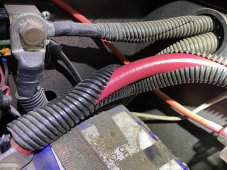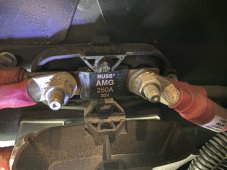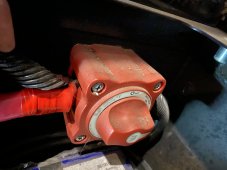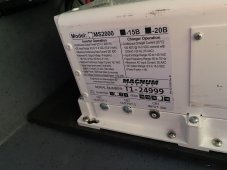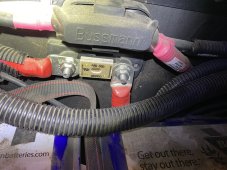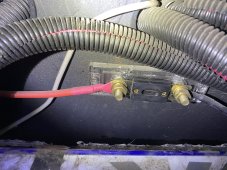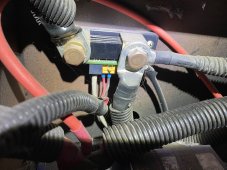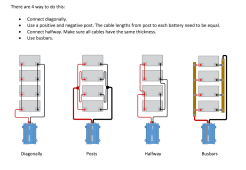TurbineTester
New Member
- Joined
- Apr 1, 2021
- Messages
- 143
Hello, this is my first real post, so please be gentle 
I'm upgrading my RV motorhome battery bank from 200Ah (2x100Ah)of BattleBorn Batteries to 1,000 Ah (5x200Ah) Ampere Time Batteries. Because i already have a 3000W Magnum 12v Inverter installed, i want to keep my house system at 12V. I'm trying to figure out how to get the max amount of permanently installed rooftop panels combined with an appropriately sized MPPT controller. I was thinking i was just going to use one of the solar kits Will recommends here. However, i'm not sure if i wanted to limit myself to only 800 watts or the 4x200W kit at Rich Solar, because i think i have enough rooftop space for at least 1200 w of panels on our 37' motorhome. I'm about to go out and measure and try some sample layouts of the 60"x30" panels at Rich Solar to see how many will actually fit. So i was looking at upgrading up to as much as the 1600W kit, but according to the diagram and manual it's only 1600w if it's connected to a 24v battery bank, it's limited to 800W at 12v output. So i'm trying to figure out what my best option for an MPPT controller might be that will work with a 12v battery bank. I know Victron makes 150v+/100A+ MPPT controllers, but i'm not sure i want to drop $800 (minimum) just on the charge controller if there is another option available. Going just on the amperage math alone, if i could fit 1600w of panels on the roof, in order to charge at 12-14.4v give or take i need to be able to output between 133A-111A (respectectively). If i can only fit 1200W of panels, that drops my demand down to 100A-83.3A needed output to not waste the PV capacity. In either case i'm already either at or really close to the max output of the $800 Victron 150v+/100A+ MPPT controller. Additionally, the panels themselves are 20V each, so in order to have 8 on the roof, i'll need to use Y branch connectors to get them in parrallel and up the amps and reduce the voltage, and i'm guessing this is ok? Like the MPPT algorithms work with whatever the input voltage/current is as long as you haven't exceeded either one, right? If i'm reading manuals correctly if you exceed the current it will limit the input current, but if you exceed the input voltage it will basically shut off the controller without damaging it. So i just want to be sure the voltage is always below the max input, right? Thanks for any help you can provide. I'm trying to get all this stuff ordered in the next 24-48 hours so it can arrive and i can install before we leave for our next trip. I already have all the batteries in our garage, just need to get the panels, controller and wires. I guess the questions i'm asking look like this:
1 - with a 3000w inverter can i run pretty much everything i need to include a roof top AC unit, or microwave provided i have appropriately sized wire (150-250A) wire and fuses/breaker from the battery bank to the inverter?
2 - What manufacturer, model and price point MPPT charge controller should i be looking at to take advantage of 1200-1600w of PN into a 12v bank?
3 - What other questions or concerns should i bee looking at?
Thanks in advance for any and all help!
I'm upgrading my RV motorhome battery bank from 200Ah (2x100Ah)of BattleBorn Batteries to 1,000 Ah (5x200Ah) Ampere Time Batteries. Because i already have a 3000W Magnum 12v Inverter installed, i want to keep my house system at 12V. I'm trying to figure out how to get the max amount of permanently installed rooftop panels combined with an appropriately sized MPPT controller. I was thinking i was just going to use one of the solar kits Will recommends here. However, i'm not sure if i wanted to limit myself to only 800 watts or the 4x200W kit at Rich Solar, because i think i have enough rooftop space for at least 1200 w of panels on our 37' motorhome. I'm about to go out and measure and try some sample layouts of the 60"x30" panels at Rich Solar to see how many will actually fit. So i was looking at upgrading up to as much as the 1600W kit, but according to the diagram and manual it's only 1600w if it's connected to a 24v battery bank, it's limited to 800W at 12v output. So i'm trying to figure out what my best option for an MPPT controller might be that will work with a 12v battery bank. I know Victron makes 150v+/100A+ MPPT controllers, but i'm not sure i want to drop $800 (minimum) just on the charge controller if there is another option available. Going just on the amperage math alone, if i could fit 1600w of panels on the roof, in order to charge at 12-14.4v give or take i need to be able to output between 133A-111A (respectectively). If i can only fit 1200W of panels, that drops my demand down to 100A-83.3A needed output to not waste the PV capacity. In either case i'm already either at or really close to the max output of the $800 Victron 150v+/100A+ MPPT controller. Additionally, the panels themselves are 20V each, so in order to have 8 on the roof, i'll need to use Y branch connectors to get them in parrallel and up the amps and reduce the voltage, and i'm guessing this is ok? Like the MPPT algorithms work with whatever the input voltage/current is as long as you haven't exceeded either one, right? If i'm reading manuals correctly if you exceed the current it will limit the input current, but if you exceed the input voltage it will basically shut off the controller without damaging it. So i just want to be sure the voltage is always below the max input, right? Thanks for any help you can provide. I'm trying to get all this stuff ordered in the next 24-48 hours so it can arrive and i can install before we leave for our next trip. I already have all the batteries in our garage, just need to get the panels, controller and wires. I guess the questions i'm asking look like this:
1 - with a 3000w inverter can i run pretty much everything i need to include a roof top AC unit, or microwave provided i have appropriately sized wire (150-250A) wire and fuses/breaker from the battery bank to the inverter?
2 - What manufacturer, model and price point MPPT charge controller should i be looking at to take advantage of 1200-1600w of PN into a 12v bank?
3 - What other questions or concerns should i bee looking at?
Thanks in advance for any and all help!



